Is the most distant galaxy discovered to date too distant? At 600 million years post big bang, this galaxy is supposed to be shrouded in hydrogen fog. See the following news posting:
http://www.physorg.com/news/2010-10-cosmic-fog-distant-galaxy-video.html
Answer to your question:
Yes, this galaxy, UDFy-3813553, presents a problem for standard cosmology since the most successful galaxy formation theory that big bang theorists have been able to propose requires at least three quarters of a billion years for a galaxy to form. This galaxy was found to have a redshift of 8.6, which gives it a big bang age of 600 million years. The big bang theory is hard pressed to explain this finding. The standard big bang theory maintains that neutral matter did not begin to form until about 450 million years after the big bang when the fireball had expanded and cooled sufficiently to allow the formerly ionized plasma to combine into neutral hydrogen and helium atoms. A date of 600 million years would leave just 150 million years for this galaxy full of stars to have formed from sparsely dispersed neutral gas, far too short a time for any galaxy formation model.
In January 26, 2011, astronomers reported finding an even more distant galaxy with a redshift of ~10, which would give it a big bang age of 480 million years. See posting at:
http://www.physorg.com/news/2011-01-hubble-contender-galaxy-distance.html. This would mean that it existed just 30 million years after the end of the Dark Age, giving it insufficient time to have formed.
In December 2012, things became even more grim for the big bang theory. An even more distant galaxy was found, UDFj-39546284, which has a redshift of z = 11.9. See posting at:
http://www.space.com/18879-hubble-most-distant-galaxy.html
This galaxy would have a big bang age of just 380 million years, which would place it 80 million years prior to the end of the Dark Age, at a time when neutral matter had not yet formed. This is a clear and blatant contradiction for the big bang theory. It does not take a rocket scientist to see that things are looking pretty tough for standard cosmology.
In 1995, in my book Beyond the Big Bang (now entitled Genesis of the Cosmos), I had stated:
“If we live in a static, tired-light universe, as the ancient cosmology and subquantum kinetics predicts, then we could expect to see star-populated galaxies with redshifts perhaps as high as thirty, forcing the big bang theory into an even more tenuous position.”Beyond the Big Bang, Rochester, VT, Park Street Press, 1995, p. 265.
At that time the most distant galaxy that had been discovered was a quasar with a redshift of z ~ 4. We have come a long way since then and I predict that ultimately my prediction will be fulfilled.
Also of interest, in June 2011 a very bright quasar ULAS J1120+0641 was discovered at a redshift of z = 7.1, which gives it a big bang age of 770 million years. Astronomer have no way to explain how a galaxy could have formed such a massive core so quickly, essentially just 200 million years after the hydrogen recombination era.http://www.physorg.com/news/2011-06-astronomers-universe-distant-quasar.html
Paul LaViolette
January 28, 2011, updated February 2013

